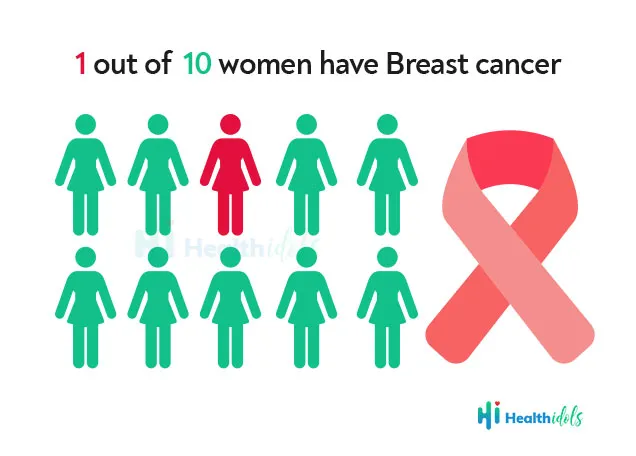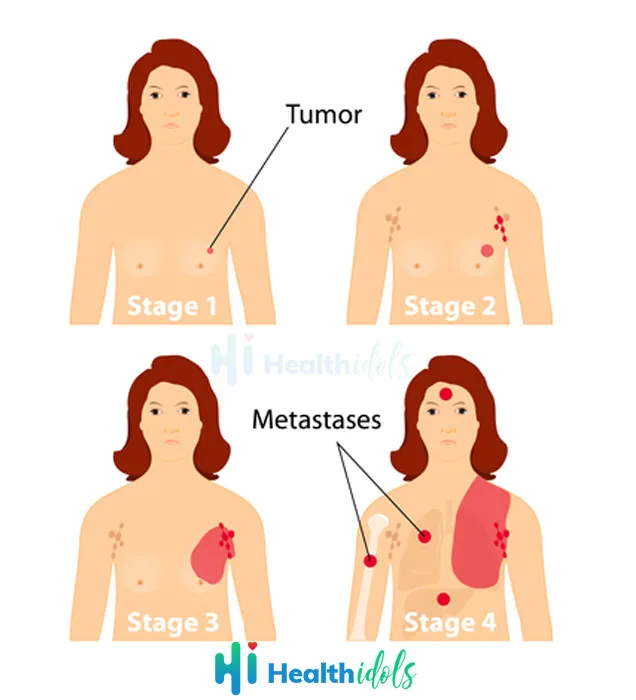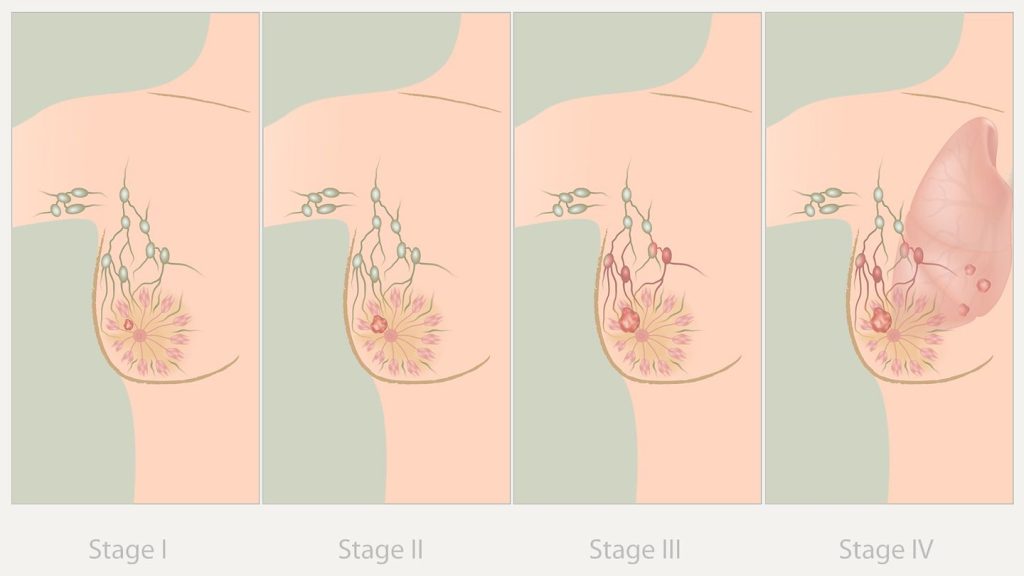Introduction
Thanks to its vast spread, breast cancer is one of those most popular types of cancer affecting women all around the planet. According to the World Health Organization, it ranks as the top cancer both globally among females and the overall second most common form of cancer in terms of new cases. Customized treatment strategies, prognosis and accurate diagnosis, both these things are crucial for understanding the various stages of breast cancer. This write-up discussed the complexities of breast cancer staging which was so informative for the readers, who were guided through each stage’s features, options of treatment, and final outcome.

What is Cancer Staging?
Cancer staging system is a systematic mechanism that identifies the germination stage when cancer has begun to spread in the body. Being precise when it comes to staging cancer is critical in the formulation of an accurate treatment plan and the estimation of patient outcomes. Considering the following factors such as, the primary tumor’s size, the extent of lymph nodes’ involvement, or the presence of metastasis serves as the basis for the notation system. Its more like a journey that may have outcome that could be different stages of the cancer from progressing to responding to treatment, therefore requires constant re-evaluations and may lead to changes of stages.
Breast Cancer Staging Systems
A most popular so far is the TNM system, which stands for the Tumor, the Node, and the Metastasis. This process depicts each component with a numerical code showing how far the diseases are in that particular part of the body.

Tumor (T):
The union of this group evaluates the size of and extension of the primary cancer in the breast tissues. The staging of breast cancer has a range of values, invoked by the T from T0 (no tumor)to T4 (the tumor has spread to adjacent tissues or the nipple).
Node (N):
The section of the procedure is devoted to analyzing lymph nodes adjacent to the affected zone. Values vary from N0 (no lymph node involvement) to N3 (the spread of cancer to walde nodes or mand fibres on the level of clavicula).
Metastasis (M):
The category shows if there are metastasizing (spreading) of cancer to internal organs or tissues around the breast and close lymph nodes. M0 indicates absence of metastasis and M1 indicates spread of tumor cells to distant body organs distant.
In accordance with the TNM metric, oncologic stage is set forth, subdivided into 6 ranges from zero (non-invasive) to four (metastatic). The occurrence of these various processes gives us a clue on how far cancer is at a given time and thus treatment decisions are carefully taken.
Stage 0: Breast Cancer Without Affecting Other Parts of The Body.
Stage 0 or non-invasive also known as in-situ of breast cancer is the point at which some of the cells in the breast ducts (ducts) or lobules (lobules) are abnormal and have not yet invaded the surrounding tissues of the breast. The most commonly encountered, in Stage 0 breast cancer cases, is DCIS or Ductal Carcinoma In Situ (DCIS). In this case, the abnormal cells stay only in the milk ducts. Non-Invasive LCIS (LCIS) as an Unwilling Bystander on the Road to Further Invasive Breast Cancer .
For the most early stages, the breast cancer can be treated with lumpectomy (removal of the lump), radiation therapy or even mastectomy (removal of the whole breast). The golden time for detecting DCIS or LCIS and for commencing the treatment for preventing the risk of the development of invasive breast cancer is the stage of early detection and timely treatment is indeed crucial.
Stage I: The earlier detectable of breast cancer was invasive.
Stage I breast cancer is a cancer type categorized as a very early invasive one wherein, the tumor being limited in size (small enough to be 2 cm) and it does not yet spread beyond the breast or into the nearby lymph nodes. This phase is represented by the first section of the model, which is broken down into Stage IA and Stage IB, based on the tumor size and lymph nodes infiltration.
When it comes to breast cancer treatments at Stage I, the regimen of lumpectomy, mastectomy, chemotherapy, targeted therapy, and radiation therapy among the most common treatment options. The prognosis for breast cancer in stage I is mainly associated and displayed by high survival rates when the disease is diagnosed and treated timely.
Stage II: Stage IV Breast cancer (LABC) referred to as Metastatic, on the other hand, has spread to the surrounding organs or beyond the breast.
Stage II is locally advanced breast cancer, it is the cancer that has spread into nearby lymph nodes or tissues within the breast but area confined to the same region. This part was further split into Stages IIA and IIB, by taking into consideration the sizes of tumor, the number of lymph nodes involved in cancer, and whether there is any spread of the cancer to nearby structures or not.
Management of II stage of the bosom cancer is a multipronged tool that includes operation (lumpectomy or mastectomy), radiation therapy, chemotherapy, as well as targeted therapies, in some cases. The degree of the involvement of lymph nodes in the formation of clinical plan is a key factor in defining AMRT. Prognosis in Stage II is positive though there is need for early staging and comprehensive care for maximum results.
Stage III: Locally advanced breast cancer part of breast cancer.
Stage III breast cancer is the advanced stage of locally advanced breast cancer which manifests with a large size turbury, involvement of lymph nodes extensively, or inflammatory breast cancer (a rare and aggressive form of breast cancer). Stage III (Stage IIIA, Stage IIIB, and Stage IIIC) is determined by the aggressiveness of tumor growth and lymph nodes, anatomical involvement.
Stage III breast cancer treatment, as a rule, is managed by a several-specialty team. The neoadjuvant therapy (before surgery) is usually performed in order to reduce the size of tumors and influence on surgery positively. As to its neoadjuvant component, it may include a chemotherapy, targeted therapies, or both. After chemotherapy, lumpectomy or mastectomy and radiation treatment ideally follows. Adjuvant therapies, like chemotherapy, and/or hormone therapy, which is also a treatment method, is usually prescribed after in addition to surgery to reduce the risk of cancer relapse.
The treatment of Stage III breast cancer, as compared to the prior stages, comes with a worse prognosis, although the improvement of many advanced treatment strategies over the recent its years have tackled that, apparently. Constant surveillance and continuation sessions to identify recurrence or metastasis is indispensable.
Stage IV: MBC is a form of breast cancer when advanced cancer cells that first appear in the breast go past the nearby lymph nodes to different regions of the body.
The metastatic breast cancer, which is indicated by stage IV, is the most advanced stage due to the fact that cancer have spread to the parts of the body beyond the breast and nearby lymph nodes to other distant organs or tissues such as the bones, lungs,liver or brain. The major objective of treatment at this stage is to inhibit cancer cell growth, soothe symptoms and improve the patient’s condition as the focus remains on keeping the patient alive rather than curing metastatic breast cancer.
Tx4 bc canceres usually involves systemic tx such as chemotherapy, pgt, or htx or a combination of these txs. Along with radiation therapy aimed at relieving symptoms or balance the metastatic disease that has spread to the localized area can also be used. In some cases, surgery may be necessary to remove a solitary metastasis or deal with problems associated with the disease. In other words, surgical intervention is sometimes the only feasible remedy.
The prognosis of Stage IV breast cancer will vary based on tumor sites such as spread of the cancer, it’s molecular characteristics and the patient overall health. In the advanced stage of metastatic breast cancer, where traditional treatment regimen have failed to bring about any cure, the research and clinical trials are ongoing in search of better and effective therapies which will not only improve survival rates but also the general quality of life for the patients.

The Path Forward: With positive changes, flares up a spark of inspiration and hope.
Learning the stages of breast cancer is an important connecting factor to make the way through the complicated process of that illness. Regular screening and detection from the earliest stages are of paramount importance which helps patients to increase the success chances of treatment and improve the prognosis. The the basis with healthcare providers is key and this enables the patient to actively take part in the decision-making process and choosing the right treatment path.
The breast cancer staging will be transferred as well, since change in stage of the disease is possible as the disease progresses or responds to the treatment. Continuous tracking and accuracy in the design of the treatment plan are the main criteria for successful treatment.
Although breast cancer is a demanding entity, progress in research, diagnostic tools, and targeted therapies keep the survival rates of patients up as they give much importance to the quality of life of the sufferers. Many agencies and support groups with the main objective of facilitating cancer patients and their loved ones with resources, information and emotional support are in the forefront helping the patients through the ups and down of the journey.
FAQ Section
1. Can patients, once breast cancer stages have already been reached, jump over any stages or revert to any ones?
No, definitively, cancer stages are as a result of an exacerbating occurrence, and they cannot be skipped or reversed. On the other hand, the right treatment may be useful in managing or even dealing with the disease through a given stage.
2. Stage does not always correlate with worse outcome.
Generally, yes. Steps of increasing numbers imply this disease is in higher stage and consequently, the prognosis is worse. Still, other factors represented by the molecular characteristics of a cancer and the overall good health of a patient are another vital elements in responsible for determining the cancer prognosis and treatment outcomes.
3. Does a breast cancer patient have a risk of recurrence after a successful treatment?
Yes, even if breast cancer is treated successfully in advance, it can still come back in later stages – especially if the diseasse have reached that far. Frequent follow-up and full investigation must be made to look for relapse especially if a remission is needed for more treatment.
4. Whether all kinds of a breast cancer are staged the same way or not?
The TNM is the most commonly used TNM staging system for breast cancer staging in the world. That said, in the case where a breast cancer tumor is of a rare or specific type they may have different staging criteria which may or may not consider these specific tumors.
5. Do lifestyle factors affect the overall course of breast cancer (the phase of the disease and its advancement)?
Although the lifestyle habits are only partly involved in staging, maintaining a healthy lifestyle (e.g., more regular exercise, a well-balanced diet, and the avoidance of nicotine) can positively influence one’s general health by improving treatment outcome while minimizing the risk of relapse or progression.
Note, in general, in this battle with breast cancer, early detection belongs to the key elements and screening is very highly important. Evaluating and exploring the pros and cons of using nutritional supplements is an important step towards informed decision-making. Therefore, if you have any doubts or want to discuss your issues, do not hesitate to consult with your healthcare provider for personalized counseling.


